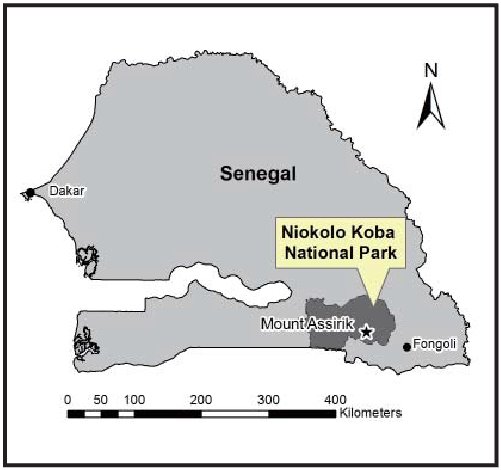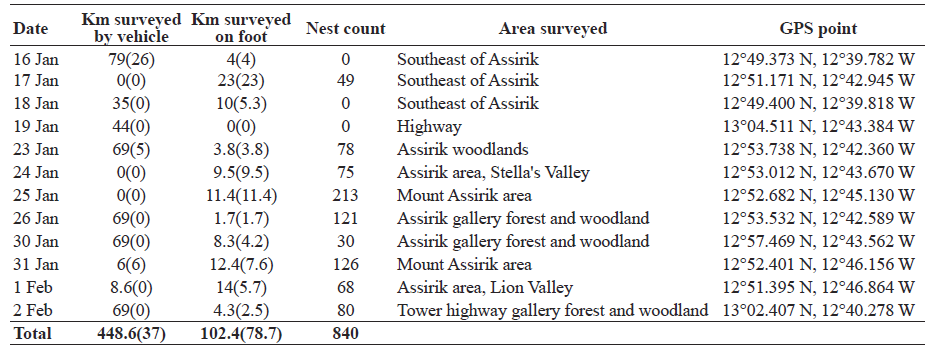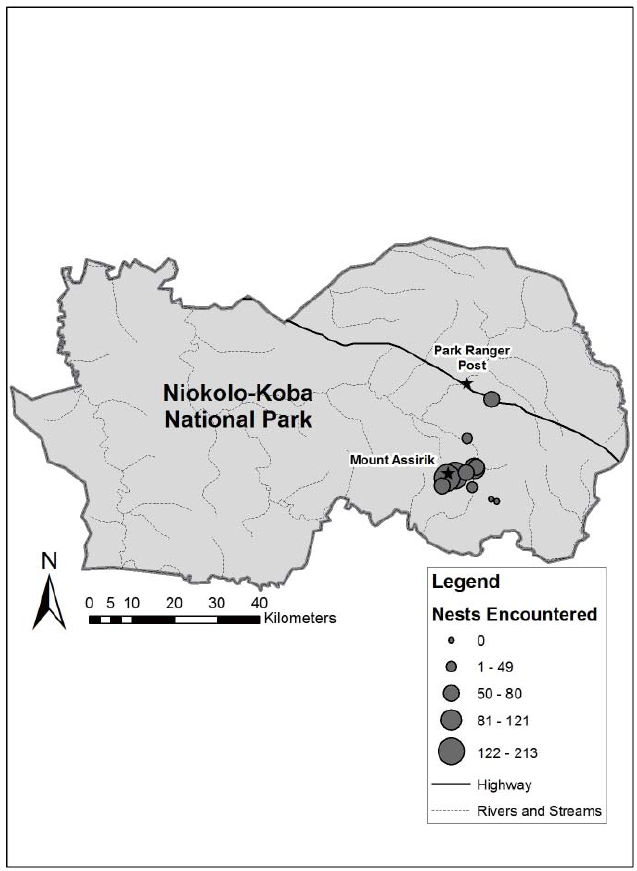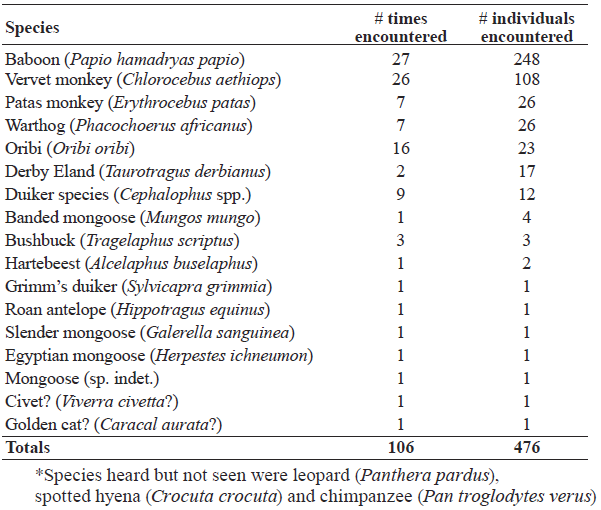|
<NOTE>
Update on the Assirik Chimpanzee (Pan troglodytes verus) Population in Niokolo Koba National Park, Senegal
Jill D. Pruetz1,2, Racine Ballahira3, Waly Camara2, Stacy Lindshield1,4, Joshua L. Marshack5, Anna Olson1, Michel Sahdiako2 & Ulises Villalobos-Flores2
1 Department Anthropology, Iowa State University, Ames, USA 2 Fongoli Savanna Chimpanzee Project, Kedougou, Senegal 3 Departmentof Research and Management, Niokolo Koba National Park, Tambacounda, Senegal 4 Ecology and Evolutionary Biology Program, Iowa State University, Ames, USA 5 Department of Anthropology, Washington University, St. Louis, USA INTRODUCTION The Assirik, Senegal chimpanzee population was studied extensively by McGrew and colleagues in the Stirling African Primate Project (SAPP) in the late 1970s1 and surveyed by the Miami Assirik Pan Project (MAPP) in 20002. These chimpanzees (thought to represent a single community3), within the Niokolo Koba National Park (or Parc National du Niokolo Koba, PNNK), remain the only protected population in the country, with most of Senegal’s chimpanzees living in unprotected areas4. In 2012, the Iowa State Assirik Primate Project (ISAPP) surveyed Assirik and outlying areas in the PNNK to assess chimpanzee density and to explore the possibility of establishing a research program there in collaboration with the National Parks Department of Senegal and University of Cheikh Anta Diop in Dakar. One objective in this study was to re-survey the Assirik area in order to compare our results to data collected in 2000. 
Figure 1. Location of Niokolo-Koba National Park in Senegal. METHODS Niokolo Koba National Park is in southeastern Senegal (12°53′ N, 12°44′ W) (Figure 1). The habitat is Sudano-Guinean mixed woodland and savanna, characterized by an extensive 7-month dry season and less than 1,000 mm of rainfall per year. The park has four diurnal non-human primate species (see Table 2) and two nocturnal species (Galago senegalensis, Potto perodicticus). Several potential mammalian predators on chimpanzees exist in the PNNK, including lion (Panthera leo), leopard (Panthera pardus), spotted hyena (Crocuta crocuta) and wild dog (Lycaon pictus)5. Table 1. Surveys of chimpanzee nests and mammals in Niokolo Koba National Park. Nest survey distances are in parentheses. 
We combined systematic line transect and reconnaissance sampling of chimpanzee nests in an effort to replicate methods from the MAPP study2. However, with less than half of the time available to conduct the survey, we did only two rather than four 2-km transects that radiated from the summit of Assirik and did not repeatedly sample areas. On 12 different days, from January 26–February 2, 2012, we surveyed 115.7 km (78.7 km on foot, 37 km by vehicle) during daylight hours for chimpanzee nests. We sampled the Mt. Assirik area as well as areas to the south and north of this summit (Table 1, Figure 2). This included two 2-km transects at the Assirik summit and 6.7 km in two forested valleys (Stella’s and Lion Valleys), in addition to searching wooded areas. In order to provide a measure of potential chimpanzee predators, prey and competitors, we calculated encounter rates (number of sightings or individuals per km) with mammals (excluding rodents and bats), on foot (102.4 km) and from the vehicle (448.6 km) between the Ranger Post to the southeastern section of PNNK. Vehicle surveys could cover the same area more than once and included encounters with animals seen on the Tambacounda-Kedougou highway running through the PNNK. 
Figure 2. Locations of nest survey areas and number of nests encountered within Niokolo-Koba National Park. We made several assumptions in our analyses of nest densities. We assumed all nests were less than 120 days old and that each weaned chimpanzee built a new nest each night. We used a formula revised from Marchesi and co-workers6: Density = (# nests/area surveyed) (1/mean nest duration [120 days]) to calculate the density of nest-building chimpanzees. We weighted our values according to habitat type since the Assirik summit transects bisected only woodland and grassland habitats, and most nests were found in gallery forests. Therefore, we calculated nest density in woodland (including bamboo woodland = 42% of area) and gallery forest (3% of area) separately in order to produce a more accurate measure of chimpanzee density in this savanna mosaic. Percentage habitat values are from Baldwin and co-workers7. No nests were found in grassland habitats during the transect surveys, which accounts for 55% of the area used by Assirik chimpanzees7. We used data from the 2.77 km transect through Lion Valley to represent chimpanzee nest density in gallery forests and used the two 2-km transects from the summit of Assirik to represent woodland habitats, multiplying these values by 3% and 42%, respectively. This procedure replicates MAPP methods2. RESULTS We recorded 840 nests built by chimpanzees in the PNNK (Table 1, Figure 2). Additionally, we heard at least one chimpanzee pant-hooting during a transect survey on the eastern slope of Assirik. Chimpanzee nest density in the PNNK was estimated at 1.28 individuals per km2. We recorded 16 mammal species during 106 sightings (0.19 per km) with 476 individuals (0.86 per km) (Table 2). We also found recent traces of poachers (e.g. shotgun shells, footprints, sounds of gunfire). During one foot survey, we encountered a group of poachers and then immediately left the area for safety reasons. Table 2. Mammal species recorded in Niokolo Koba National Park*. 
DISCUSSION Although our results from this brief survey indicate that the chimpanzee population in the PNNK increased since the MAPP survey, from 0.13 nest-building chimpanzees per km2 calculated in 20002 to 1.28 in this study, such an interpretation should be made with caution. The results reported here accounted for less than 7 km of line transects, compared to the 13.7 km surveyed in the 2000 study2. Plumptre8 recommend surveying at least 200 km for forest-dwelling primates. However, effective sampling distances in a savanna environment are likely to be shorter because detection distances (i.e. strip width) are larger. In the MAPP survey2, a detection distance of 36 m was calculated based on nest sighting distances, suggesting a strip width of 72 m provided a reliable estimate of chimpanzee nest density in this environment. Nonetheless, given the brief nature of our study, our comparative analysis should be used primarily as a relative measure of the presence and location of chimpanzees in the PNNK over the years. However, we found a large number of chimpanzee nests during a relatively brief survey, which is encouraging. We recorded more nests in 2012 relative to the 2000 survey, although nest encounter rates (nests per km) were higher in 2000. A total of 29 km (on foot) and 54 km (via vehicle) were surveyed during the MAPP study2 compared to the current effort of 78.7 km and 37 km surveyed by foot and vehicle, respectively. We recorded 840 nests along 115.7 km (7.3 nests per km surveyed), while MAPP recorded 736 nests along 83 total km (8.9 nests per km surveyed). We attribute the lower encounter rate in 2012 to reconnaissance sampling more than 10 km southeast of the Assirik summit, where no nests were observed (Figure 2). Based on our 2012 records of nests in new areas surveyed relative to the 2000 study, we suggest that at least two chimpanzee communities use the PNNK, in contrast to the findings of Tutin and co-workers3. We recorded nests more than 20 km north of Mount Assirik (Figure 2). At the Fongoli site, less than 60 km from Assirik (Figure 1), the chimpanzees’ home range is over 86 km2, and the furthest distance between points used by this community is around 10 km (Pruetz & Wessling, in prep.). We hypothesize that PNNK chimpanzees exhibit similar ranging patterns, and may in fact have smaller home ranges than chimpanzees outside of the PNNK since they do not experience anthropogenic disturbance, which accounts for 5% of the Fongoli range9. Although both the 2000 and the 2012 surveys occurred during the dry season (February–March and January, respectively), data on Fongoli chimpanzees indicate that savanna chimpanzees in Senegal use their home ranges seasonally and cyclically. Fongoli chimpanzees range most widely during the early dry season, when baobab is fruiting. It is possible that Assirik chimpanzees do so as well, ranging more widely from the summit during the early dry season (November–January) compared to the late dry season (February–April) due to the widespread dispersion of baobab trees, a key food source for Fongoli chimpanzees10. In any case, the harsh savanna environment coupled with confirmed poaching activity within the park’s borders underscores the need for increasing conservation and management efforts for Assirik chimpanzees. Given the increasing human population in Senegal, it is possible that the human community surrounding PNNK will exert increasing competitive and predation pressures on chimpanzees in the years to come. The increasing human population of Senegal is attributed to rising birth rates and immigration from surrounding countries. Large-scale mining is increasing here, and smaller-scale artisanal mining attracts people from other countries who may not have the same cultural values that have resulted in the protection of Senegal’s chimpanzees via taboos against eating them4. The large mammal population in the PNNK is thought to be under increased pressure from poachers, and their presence could also affect the behavior of chimpanzees in this area, although they are not yet thought to be the target. We found more evidence of poachers in our 12 days in the PNNK than JDP observed in over 2 months during the 2000 study. As mining continues to develop in Senegal, the market for bushmeat is likely to increase even more, indicating the need to better protect this important area of wildlife diversity. ACKNOWLEDGMENTS We thank the Republic of Senegal, Direction des Parcs Nationaux, especially Docteur Djibril Diouck, Commandant Mamadou Sidibe, and the rangers at Niokolo Koba Post for assistance. We thank Gray Tappan for information on the location of chimpanzees in the PNNK, Erik Otarola-Castillo for technical advice, and WCM McGrew for helpful comments on this manuscript. REFERENCES
Back to Contents |